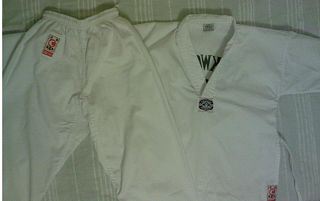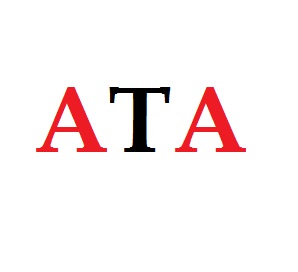
Taekwondo, also spelled tae kwon do or taekwon-do, is a Korean martial art and combat sport involving punching and kicking techniques. The literal translation for taekwondo is "kicking", "punching", and "the art or way of". It sometimes involves the use of weapons.

International Taekwon-Do Federation (ITF) is an international taekwondo organization founded on March 22, 1966, by Choi Hong Hi (Korean: 최홍희) in Seoul, South Korea. The ITF was founded to promote and encourage the growth of the Korean martial art of taekwon-do.

Dobok (Korean: 도복) is the uniform worn by practitioners of Korean martial arts, such as taekwondo. Do means "way" and bok means "clothing". The dobok came from the Japanese keikogi/dōgi, used in Japanese martial arts, such as judo.

Tang Soo Do is a Korean martial art based on karate and may include fighting principles from taekkyeon, subak, as well as northern Chinese martial arts. From its beginnings in 1944 to today, Tang Soo Do is used by some Kwans to identify the traditional Korean fusion of martial arts styles. In the mid 1950s, Tang Soo Do became the basis for the martial art Taekwondo when the Korean Nine Kwans united.
In taekwondo, taegeuk is a set of Pumsae, or defined pattern of defense-and-attack forms used to teach taekwondo.
Rhee Taekwon-Do, also known as Rhee Tae Kwon-Do, Rhee Tae Kwon Do, or Rhee Taekwondo,[a] is a martial art school in Australia[b] teaching the Korean martial art of taekwondo. Its full name is "Rhee International Taekwon-Do (Australia)". Chong Chul Rhee, one of the original masters of taekwondo, founded the school in the mid-1960s. Two of Rhee's brothers, Chong Hyup Rhee and Chong Yoon Rhee, later came to assist him in the 1970s.

Korea Taekwondo Association, originally the Korea Tang Soo Do Association (1961), is the first taekwondo organisation. It was founded in 1959,[a] although official South Korean sources give 1961 as its year of establishment.[b] In 1966, some members of the KTA, led by H. H. Choi, broke off from the KTA and formed the International Taekwon-Do Federation (ITF). The Kukkiwon and the then-World Taekwondo Federation were created by the KTA in the early 1970s. The KTA sits under the Korea Sports Council, is aligned with Kukkiwon, and is a Member National Association (MNA) of the WT. Its goal is to promote the martial art taekwondo as a national sport within South Korea.
The Korean terms hyeong, pumsae, poomsae and teul are all used to refer to martial arts forms that are typically used in Korean martial arts such as Taekwondo and Tang Soo Do.

ATA Martial Arts, formerly known as the American Taekwondo Association (ATA), was founded in 1969 in Omaha, Nebraska by Haeng Ung Lee of South Korea.

Taekwondo was introduced to the Philippines through the efforts of Kim Bok Man and Young Man Park. Grand Master Kim Bok Man arrived in 1970 to continue Park's legacy of propagating Taekwondo upon the invitation of President Marcos. Kim continued to pioneer Taekwondo worldwide and left the Philippines in 1971. In 1975, Grand Master Hong Sung-chon came to the Philippines to promote Taekwondo, eventually establishing the Philippine Taekwondo Association (PTA). The current central headquarters of the PTA is at the Rizal Memorial Sports Complex. The PTA is a member of the Kukkiwon, World Taekwondo Federation, Philippine Sports Commission, Philippine Olympic Committee and Asian Taekwondo Union.
Chung Do Kwan, created by Won Kuk Lee in 1944, is one of the first of nine schools or kwan teaching Tang Soo Do. Later, the school began to teach what came to be known as taekwondo. This style of Tang Soo Do is known for its overall power and emphasis on kicks to the head.
Edward B. Sell was an American martial arts instructor, and the highest ranking non-Korean practitioner of tae kwon do, holding the honorary rank of 10th degree black belt in the art. Sell founded the U.S. Chung Do Kwan Association.

British Taekwondo Limited, operating as British Taekwondo is the National Governing Body for World Taekwondo in Great Britain. It is a member of, and recognised by, World Taekwondo, the international governing body for taekwondo as recognised by the International Olympic Committee and the International Paralympic Committee. British Taekwondo is also a member of the British Olympic Association (BOA), the British Paralympic Association (BPA) and the European Taekwondo Union (ETU).
Cho Hee-il is a prominent Korean-American master of taekwondo, holding the rank of 9th dan in the martial art. He has written 11 martial art books, produced 70 martial art training videos, and has appeared on more than 70 martial arts magazine covers. Cho won several national and international competitions as a taekwondo competitor, and has appeared in several films, including Fight to Win, Best of the Best, Bloodsport II, and Bloodsport III. He founded the Action International Martial Arts Association (AIMAA) in 1980, and is its President. Cho is a member of both Black Belt magazine's Hall of Fame and Tae Kwon Do Times magazine's Hall of Fame.
The European Taekwondo Championships are the European senior championships in Taekwondo, first held in Barcelona in 1976. The event is held every two years and is organized by the European Taekwondo Union, the continental affiliate of World Taekwondo, which organises and controls Olympic style taekwondo. An additional event, the G4 Extra European Taekwondo Championships were exceptionally held in 2019.
Taegeuk Ee Jang is the second of eight taekwondo forms practiced by the Kukkiwon and the World Taekwondo Federation. A form, or poomsae, is a choreographed pattern of defense-and-attack motions. Taegeuk Ee Jang is considered a beginner form, often practiced by students of Kukkiwon/WTF-style taekwondo with rank of 7th geup. Seventh geup students of Kukkiwon/WTF-style taekwondo practice this form in order to advance to the next rank.
Taegek Sam Jang is the third of eight taekwondo forms practiced by the Kukkiwon and the World Taekwondo Federation. A form, or poomsae, is a choreographed pattern of defense-and-attack motions. Taegeuk Sam Jang is often practiced by students of Kukkiwon/WTF-style taekwondo with rank of 6th geup. Sixth geup students of Kukkiwon/WTF-style taekwondo practice this form in order to advance to the next rank.
Taegeuk Chil Jang is the seventh of eight taekwondo forms practiced by the Kukkiwon and the World Taekwondo Federation. A form, or poomsae, is a choreographed pattern of defense-and-attack motions. Taegeuk Chil Jang is often practiced by students of Kukkiwon/WTF-style taekwondo with rank of 2nd geup. Second geup students of Kukkiwon/WTF-style taekwondo practice this form in order to advance to the next rank.
Taegeuk Pal Jang is the last of eight taegeuk taekwondo forms practiced by the Kukkiwon and the World Taekwondo Federation. A form, or poomsae, is a choreographed pattern of defense-and-attack motions. Taegeuk Pal Jang is often practiced by students of Kukkiwon/WTF-style taekwondo with rank of 1st geup. First geup students of Kukkiwon/WTF-style taekwondo practice this form in order to advance to the next rank, at which students then begin studying a new sequence of black belt forms.







